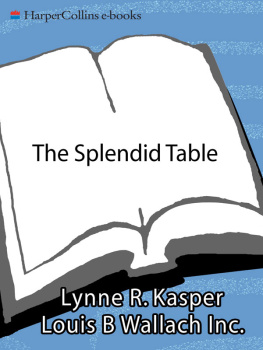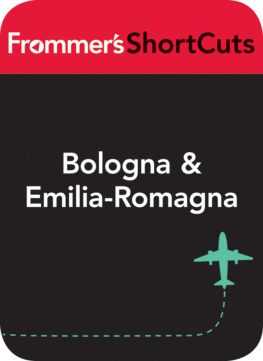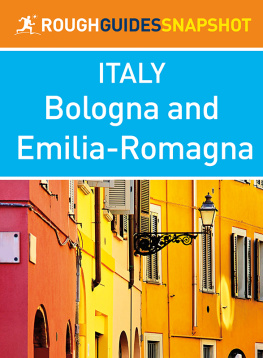A sk an Italian where to eat only one meal in Italy and, after recommending his mothers house, it is more than likely he will send you to the region of Emilia-Romagna. Few foreigners know the region by name, but even those people with only a passing interest in food recognize its products. By law, Parmesan (Parmigiano-Reggiano) cheese and Prosciutto di Parma (one of Italys two most admired prosciutti ) can be produced only in Emilia-Romagna. And its wealth of handmade pastas, including the famed tortellini, are admired far beyond its borders .
Balsamic vinegar originated here over a thousand years ago. Even though imitations are now made from Naples to Milan, the great balsamicsthe ones that are aged for decades and are luscious enough to be sipped like liqueursare made only in the region .
The regions cuisine is as complex as an intricately woven tapestry. There is a peasant kitchen, a thriving middle-class cuisine, and the highly refined traditions of the regions nobility. This book is about five centuries of that culinary heritage .
If only one word could describe Emilia-Romagna, it would have to be rich. Not rich in the sense of fat, but rich in dishes of deep, layered tastes. Even at its simplest, Emilia-Romagnas food tastes as if it has evolved from a long tradition. Yet there is always a spontaneity to what you eat .
Emilia-Romagna sits between Florence and Venice, to the south of Milan. The wedge-shaped region nudges its way into northern Italy from the Adriatic Sea. Its borders are formed by the Adriatic coast, the Po River and the peaks of the Apennines. The region is half mountains and half plains. Its geography is crucial to its cuisine .
If this book were a novel, two of its main characters would be the Po River plain and the road called the Via Emilia. A large section of the plain, Italys largest and most fertile expanse of land, lies within Emilia-Romagnas borders. That plain (the Padano) has made the region a major agricultural force. Its rich grazing and good land produces Parmigiano-Reggiano (Parmesan) cheese, Parma ham and the wheat for an extraordinary variety of handmade pastas .
When the Romans built Italys main north-south trade route, the Via Emilia, they ran it up the entire length of Emilia-Romagna. That road, along with the east-west routes that crossed it, made Emilia-Romagna a crossroads for all of northern Italyincluding her two major ports, Genoa and Venice, and their links to the worlds of the East and West. It tied the region to northern, central and eastern Europe, and to Rome and the south. Each link brought traders, visitors, and conquerors with their new foods, dining traditions and ideas. Today a superhighway parallels the Via Emilia .
The original road is Main Street to six of Emilia-Romagnas eight provincial capitals: Piacenza, Parma, Reggio, Modena, Bologna and Forl. Each of these cities grew up on the Via Emilia at a point where it was crossed by a major trade road out of the Apennines. The two remaining provincial capitals lie out on the Po plain. Ravenna, the ancient Roman seaport and later the western capital of the Byzantine Empire, sits on the old route from Rome to Venice. Ferrara is farther inland, on the road connecting Florence, Bologna and Ferrara with Venice .
Ferraras strategic placement on the banks of the Po not far from the Adriatic gave her control of northern Italys most important river and delta. That piece of geography helped Ferraras Este family create and sustain one of the most powerful and long-lived dynasties of the Renaissance. Among the legacies of the Este are invaluable written records of their feasts and foods, dishes that are still a vital part of Ferraras cooking today .
Food changes subtly and sometimes dramatically from one part of Emilia-Romagna to another. Once you are inside, you discover that each area has its own stylethe elegant restraint of Parmas cooking, the medieval flavors still dominating Ferraras foods, Bolognas lustiness and complexity, the richness and slightly countrified quality of Modenas dishes, Reggios refinements, Piacenzas blending of the three regions pressing at her borders, and the underlying simplicity of Forls and Ravennas specialties .
Emilia and Romagna were created by warring Romans and Gauls. The first Etruscan and Greek settlers gradually gave way to the Gauls from the north, who were attracted by the areas rich land and vineyards. Expanding their empire north from Rome, the Romans challenged the Gauls for possession of the region. The Gauls stopped the advancing legions south and east of Bologna. That area remained Roman, or Romagna, while the plains and mountains to the west and north eventually became Emilia. Finally Rome gained all of Emilia-Romagna and the regions Roman settlers went on to create some of the earliest written records of the regions foods .
Today the border between Romagna and Emilia is still elusiveI have yet to see it marked on a regional map. Everyone agrees that Romagna encompasses all of the regions Adriatic coast, including the provinces of Forl and Ravenna. Part of Ferrara province falls under Romagna, but not Ferrara city. Romagna also includes part of Bologna province, but stops somewhere (few agree precisely where) short of the city of Bologna. Emilia includes the provinces of Piacenza, Parma, Reggio, Modena and part of Ferrara. A portion of Bologna province and, technically, all of Bologna city are Emilian. But Bologna is the regions capital, and the Bolognese make a strong point of being neither of Emilia nor Romagna but an entity unto themselves .
Through the centuries, Romagna generally remained under the control of forces outside the region. First it was under the rule of the Roman Empire, then of the Byzantine Empire, and finally of the church as part of the Papal State, which joined Romagna with central Italy. Local noble families periodically wrested away land and gained power, but usually they lost it again, and Romagna remained of Rome and the papacy .
As a result, today Romagnas food is more unified than Emilias, tasting more of central Italy than of the north. Certainly each area of Romagna has its specialties and its own character, but provincial distinctions and the elaborate dishes of old court life are less prominent here than in Emilia. Food in Romagna tends to be more direct and assertivethe everyday and feast-day dishes of townspeople, farmers, and fishermen .
Emilias destiny was different. After the Roman Empire crumbled and local lords jousted for rule of the plains and mountains during the Dark Ages, Emilia was divided among a handful of Renaissance families .
All of Ferrara, Modena and Reggio were ruled by the Este family from 1208 to 1598. Then Ferrara passed to the Pope, and the Este packed up six hundred wagons with three hundred years worth of possessions and caravanned across the Po plain to make Modena their new capital. They ruled Modena and Reggio until the mid-1800s, when their alliances with Austria took the last Este duke to Vienna and Modena and Reggio became part of unified Italy .
Parma and Piacenza went from papal possession to a duchy ruled between 1545 and 1732 by the Farnese dukes originally from Rome. They then passed to France, Austria, and finally joined the Italian unification movement. Those centuries as a center of court for some of the mightiest powers in Europeas an annex to the 18th-century court of Louis XV, it was known as the Athens of Italygave Parmas food its foundations of refinement and finesse .







